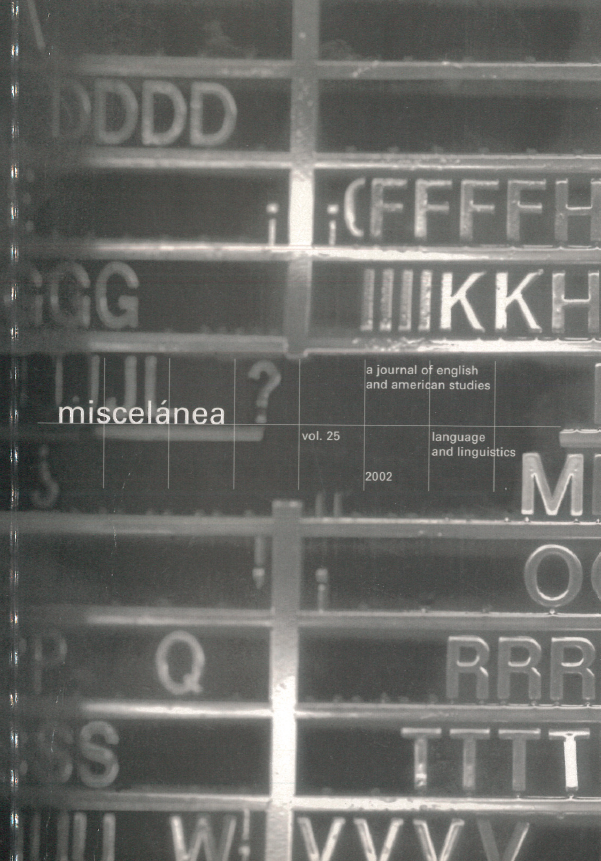The Effect of Language Proficiency on Communication Strategy Use: A Case Study of Galician Learners of English
DOI:
https://doi.org/10.26754/ojs_misc/mj.200210524Keywords:
communication strategy, avoidance, paraphrase, conscious transfer, essential structure analysisAbstract
This paper presents an investigation carried out in order to study the effect that language proficiency has on the use that Galician learners of English as a foreign language make of communication strategies (CS). The results obtained suggest that quantitative measures of CS instances alone cannot provide a fair picture of the use that language learners make of these devices. In analyzing CS use it is necessary to bear in mind that, in the accomplishment of the apparently same communicative tasks, different subjects set different communicative goals which directly influence their use of these strategies. On account of this, in the present study frequency and choice of CS use in a given set of tasks is related to the amount and lexical complexity of the content communicated. In this way, evidence is obtained that more proficient students use CS less frequently than lower level ones and that, in terms of CS choice, more advanced students make more frequent use of paraphrase strategies, rather than avoidance or conscious transfer strategies, than less advanced learners.
Downloads
References
BIALYSTOK, Ellen. 1983. “Some Factors in the Selection and Implementation of Communication Strategies.” In Faerch, Claus and Gabriele Kasper. (eds.). Strategies in Interlanguage Communication. London: Longman: 100-118.
—. 1990. Communication Strategies: A Psychological Analysis of Second Language Use. Oxford: Basil Blackwell.
BIALYSTOK, Ellen and Maria FRÖHLICH. 1980. “Oral Communication Strategies for Lexical Difficulties.” Interlanguage Studies Bulletin 5 (1): 3-30.
CLARK, Herbert H. and Deanna WILKES-GIBBS. 1986. “Referring as a Collaborative Process.” Cognition 22 (1): 1-39.
CORDER, S. Pit. (1978) 1983. “Strategies of Communication.” In Faerch, Claus and Gabriele Kasper. (eds.): 15-19.
DÖRNYEI, Zoltan. 1995. “On the Teachability of Communication Strategies.” TESOL Quarterly 29 (1): 55-85.
ERVIN, Gerard. L. 1979. "Communication Strategies Employed by American Students of Russian.” The Modern Language Journal 63 (7): 329-334.
FAERCH, Claus and Gabriele KASPER. 1983. “Plans and Strategies in Foreign Language Communication.” In Faerch, Claus and Gabriele Kasper. (eds.): 20-60.
FERNÁNDEZ DOBAO, Ana M. 1999. Communication Strategies Used by Galician Students in their Learning of English as a Foreign Language: A Case Study. Unpublished master's thesis. University of Santiago de Compostela.
—. 2001. “Communication Strategies in the Interlanguage of Galician Students of English: the Influence of Learner and Task-Related Factors.” Atlantis 23 (1): 41-62.
—. 2002. “The Use of Non-Verbal Communication Strategies in Native-Nonnative Speaker Interactions: A Case Study of Spanish Learners of English as a Foreign Language.” Paper presented at the 26th AEDEAN Conference. Santiago de Compostela. December 2002.
GRICE, H. Paul. 1975. “Logic and Conversation.” In Cole, Peter and Jerry L. Morgan. (eds.). Syntax and Semantics, vol. 3. New York: Academic Press: 41-58.
HAASTRUP, Kirsten and Robert PHILLIPSON. 1983. “Achievement Strategies in Learner/Native Speaker Interaction.” In Faerch, Claus and Gabriele Kasper. (eds.).: 140-158.
HYDE, John. 1982. “The Identification of Communication Strategies in the Interlanguage of Spanish Speakers of English.” Anglo-American Studies 2 (1): 13-30.
JOURDAIN, Sarah. 2000. “A Native-Like Ability to Circumlocute”. The Modern Language Journal 84 (2): 185-195.
KHANJI, Rajai. 1993. “Interlanguage Talk: the Relation between Task Types and CS among EFL Arab Learners.” In Alatis, James E. (ed.). Georgetown University Round Table on Language and Linguistics 1993. Washington D.C.: Georgetown U. P: 428-436.
LEECH, Geoffrey. 1983. Principles of Pragmatics. London: Longman.
LISKIN-GASPARRO, Judith E. 1996. “Circumlocution, Communication Strategies, and the ACTFL Proficiency Guidelines: An Analysis of Student Discourse.” Foreign Language Annals 29 (3): 317-330.
LITTLEMORE, Jeannete. 2001. “An Empirical Study of the Relationship between Cognitive Style and the Use of Communication Strategy.” Applied Linguistics 22 (2): 241-265.
LUJAN-ORTEGA, Violante and David CLARK-CARTER. 2000. “Individual Differences, Strategic Performance and Achievement in Second Language Learners of Spanish” Studia Lingüística 54 (2): 280-287.
MANCHÓN RUIZ, Rosa M. 1989. "Competencia estratégica y evolución de la interlengua del aprendiz de una L2.” In Labrador Gutiérrez, Tomás, Rosa María Sáinz de la Maza and Rita Viejo García. (eds.). Adquisición de lenguas: teorías y aplicaciones. Actas del VI congreso nacional de AESLA. Madrid: Asociación Española de Lingüística Aplicada: 377-388.
PARIBAKHT, Tahereh. 1985. “Strategic Competence and Language Proficiency.” Applied Linguistics 6 (2): 132-146.
POULISSE, Nanda. 1990. “Variation in Learners' Use of Communication Strategies.” In Duda, Richard and Philip Riley. (eds.). Learning Styles. Nancy: Presses universitaires de Nancy: 77-87.
—. 1997. “Compensatory Strategies and the Principles of Clarity and Economy.” In Kasper, Gabriele and Eric Kellerman. (eds.). Communication Strategies: Psycholinguistic and Sociolinguistic Perspectives, Edinburgh: Longman: 49-64.
POULISSE, Nanda, Theo BONGAERTS and Eric KELLERMAN. 1987. “The Use of Retrospective Verbal Reports in the Analysis of Compensatory Strategies.” In Faerch, Claus and Gabriele Kasper. (eds.). Introspection in Second Language Research. Clevedon: Multilingual Matters: 213-229.
—. (eds.). 1990. The Use of Compensatory Strategies by Dutch Learners of English. Dordrecht: Foris.
POULISSE, Nanda and Erik SCHILS. 1989. “The Influence of Task- and Proficiency-Related Factors on the Use of Compensatory Strategies: a Quantitative Analysis.” Language Learning 39 (1): 15-47.
SI-QING, Chen. 1990. “A Study of Communication Strategies in Interlanguage Production by Chinese EFL Learners.” Language Learning 40 (2): 155-187.
TARONE, Elaine. 1977. “Conscious Communication Strategies in Interlanguage: a Progress Report.” In Brown, H. Douglas, Carlos A. Yorio and Ruth Crymes. (eds.). On TESOL’77. Washington D.C.: TESOL: 194-203.
—. 1981. “Some Thoughts on the Notion of Communication Strategy.” TESOL Quarterly 15 (3): 285-295.
—. 1984. “Teaching Strategic Competence in the Foreign-Language Classroom." In Savignon, Sandra J. and Margie S. Berns. (eds.). Initiatives in Communicative Language Teaching. Reading, MA: Addison-Wesley: 127-136.
TARONE, Elaine and George YULE. 1987. “Communication Strategies in East-West Interactions.” In Smith, Larry E. (ed.). Discourse Across Cultures, Strategies in World Englishes. New York: Prentice Hall: 49-65.
—. 1989. Focus on the Language Learner. Oxford: Oxford U. P.
YULE, George. 1997. Referential Communication Tasks. Mahwah, N. J.: Lawrence Erlbaum.
Downloads
Published
How to Cite
Issue
Section
License
Copyright (c) 2002 Ana María Fernández Dobao

This work is licensed under a Creative Commons Attribution-NonCommercial 4.0 International License.


